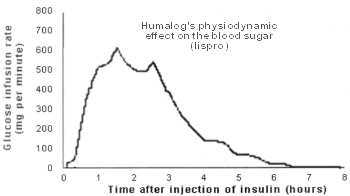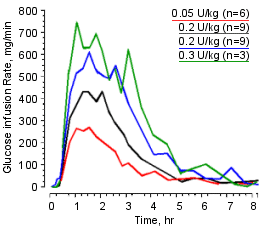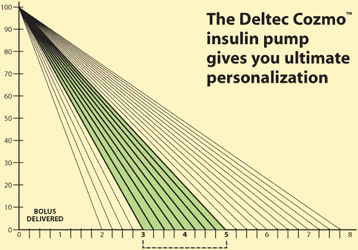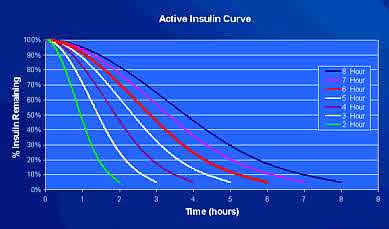An unanticipated problem faces pumpers who use the newer smart pumps: how to select a duration of insulin action that works for them but does not create problems. Insulin action does vary. In one study of Novolog, there was about a 25% variation in action between different users (Diabetes Care #11: pgs 1910-1914, Nov 21, 1998). This means that adjusting insulin action time to individual needs in a pump makes sense. Still, a 25% variation means that insulin duration time varies by only about one to, at most, two hours, not the 2 to 8-hour period available in today’s pumps.
Most pump users and healthcare professionals do not realize how important setting up the duration of insulin action in a pump is for achieving reasonable control. For example, many people choose to set the duration of insulin action to short values, such as 2 or 3 hours, because they falsely believe their insulin works very quickly for them.
Although called “rapid insulin,” Novolog and Humalog are not that fast, having little effect on the glucose for the first 15 to 20 minutes, reaching the halfway point in activity at just over two hours, and then trailing off in activity over about 6 hours. (See Fig. 1 to the right.)
However, users can get tricked into thinking their insulin is faster. They may have taken a bolus and gotten low right away because a previous bolus was still working or the basal is set too high. They may have taken a bolus for a meal but gone very low a couple of hours later because they overestimated the carbs in the meal or the carbs had a low glycemic index.
Parents of children with diabetes are especially vulnerable to “shortactionitis”. Because children are more sensitive to insulin, parents may become convinced their child’s insulin works fast rather than that they might have received a half unit too much insulin. In a study that is not yet published, Dr. Bruce Buckingham, a pediatric endocrinologist at Stanford, looked at how quickly rapid insulins worked in young children. In his detailed study of 11 children using glucose clamps, he was surprised to find that rather than working rapidly; their insulin worked slower than in published reports for adults.
Insulin duration does not vary that much. A 25% variation means the peak of action, typically just after 2 hours, might vary between 1 hour and 45 minutes and 2 hours and 15 minutes for most everyone. Assuming a total average duration of six hours, including the tail, the variation between different pumpers would be 5 hours and 15 minutes to 6 hours and 45 minutes, not 2 to 8 hours!!!

When insulin duration is set too short, excess amounts of unrecognized bolus insulin accumulate as boluses overlap, usually in the afternoon and evening. For example, if a 3-hour duration is set in the Cozmo or Paradigm pumps (roughly equivalent to 2 hours in the Animas 1200), a breakfast bolus given at 7 a.m. appears to have no residual activity past 10 a.m. If a high reading occurs at that time, more bolus insulin than needed will be given. At lunch, the bolus will again be excessive regardless of the blood glucose at that time. The hypoglycemia that follows often causes the pumper to suspect their basal insulin delivery is too high because there is no “active insulin” around.
This unrecognized bolus stacking causes the pump user to lower their basal insulin delivery inappropriately because the BOB appears smaller than it really is because the insulin duration is set too short. If the basal rates are then lowered, high readings happen more often and are treated with excessive amounts of corrective boluses. Unless the source of the problem is recognized as duration of insulin action that is too short, control problems continue.
|
Table 1: Residual Insulin Action (BOB) For Various Bolus Duration Times Automatically calculated in today’s smart pumps |
||||||
|---|---|---|---|---|---|---|
| Bolus Duration | Hours After A 10 Unit Bolus | |||||
| Time | 0 hrs | 1 hr | 2 hrs | 3 hrs | 4 hrs | 5 hrs |
| Cosmo 3 hrs | 10 u | 6.7 u | 3.3 u | 0 u | 0 u | 0 u |
| Cosmo 4.5 hrs | 10 u | 7.8 u | 5.6 u | 3.3 u | 1.1 u | 0 u |
| Cosmo 5.5 hrs | 10 u | 8.2 u | 6.4 u | 4.5 u | 2.7 u | 0.9 u |
| Paradigm 8 hrs | 10 u | 9.0 u | 6.6 u | 4.2 u | 2.4 u | 1.3 u |
Setting up insulin duration is made difficult for clinicians and users because of the excessively wide range of times allowed in today’s pumps and because different pumps calculate insulin duration differently. For instance, the Cosmo pump and Paradigm 515/715 pumps allow users to select action times that range from 2 to 8 hours, but they differ in how they determine the amount of residual insulin. The Animas 1200 pump allows time settings between 1.5 and 6.5 hours, but their action time in 1200 represents when 70% of the insulin action will have passed. To give you an idea of the problem this creates for clinicians, a 3.5 hour setting on the Animas 1200 is equivalent to 8 hours on the Paradigm and 5.5 hours on the Cozmo as shown in Table 1.
The question, of course, for pumpers, is what time should I select for my pump? Table 2 for our recommendations for each pump. or Novolog or Humalog insulin, most Cozmo users should select between 4 hours and 30 minutes to 5 hours and 30 minutes action time (see a graph of Humalog action to the right)
This wide range can introduce major problems with control because of how it affects bolus dose calculations when active insulin or BOB is present.
Fig. 1 adapted from Johnson MD, White JR, Campbell RK. Insulin therapy in the era of insulin analogs. U.S. Pharmacist 1996;21:HS35-HS44
Ref:
1. Woodworth et al. Diabetes. 1993;42(Suppl. 1):54A.
2. Howey DC et al. Diabetes 1994; 43: 396-402.
Last Updated on December 20, 2024



